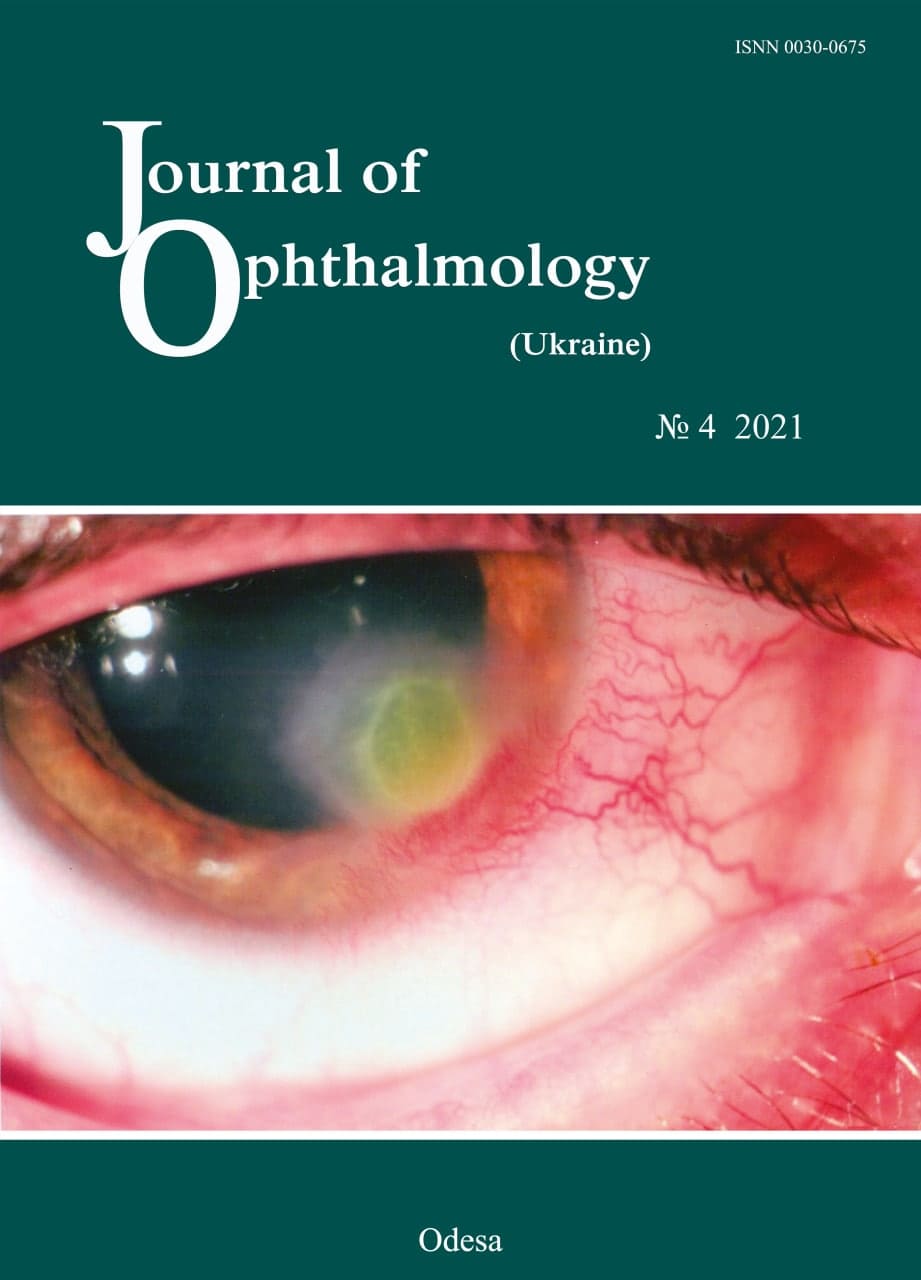Ultrastructural changes in the chorioretinal complex of the rat after inducing form-deprivation axial myopia only, diabetic retinopathy only and diabetic retinopathy in the presence of myopia
DOI:
https://doi.org/10.31288/oftalmolzh202147278Keywords:
streptozotocin-induced diabetes, form-deprivation myopia, rats, electron microscopy, choroidal ultrastructure, retinal pigment epithelium, compensatory processesAbstract
Purpose: To determine the features of the microstructure of choreoretinal complex in rats with diabetes induced by streptozotocin in the presence of axial myopia.
Material and Methods: Fifty-five Wistar rats (110 eyes; age, 2 weeks to 14 weeks) were used in experiments. Four groups were formed: group 1 (axial myopia only); group 2 (diabetes only); group 3 (both myopia and diabetes); and group 4 (controls; intact animals). High form-deprivation myopia was produced in two-week animals by surgically fusing the eyelids of both eyes and these animals were maintained under conditions of reduced illumination for two weeks to induce a more intense myopization of the globe. Eyelid sutures were removed on completion of these two weeks. Two weeks thereafter, type 2 diabetes mellitus was induced in rats with induced axial myopia and intact rats. A 50 mg/kg intraperitoneal streptozotocin injection for 5 days was used for this purpose. Elongated axial length and increased anterior chamber depth as measured by in vivo ultrasound were an objective criterion of the development of myopia in experimental animals. A glucose level of ≥ 4.5 mmol/L was a criterion of the development of diabetes. Two months after inducing diabetes, 14-week rats were sacrificed, and their eye tissue samples were processed by a routine method and assessed by electron microscopy. Ultrastructure of the choroid, RPE, and retinal photoreceptor cells were examined. Ultra-thin sections were cut, stained with lead citrate according to the procedure described by Reynolds, and observed with a PEM-100-01 Transmission Electron Microscope.
Results: Our ultrastructural study found that myopization of the rat globe with elongation of the axial length somewhat reduced the severity of some ultrastructural changes in the choreoretinal complex in induced type 2 diabetes due to reduced choroidal swelling and dominance of compensatory processes with increased energy producing, protein synthesis and other functions in the endothelial vessels and choriocapillaries as well as RPE cells. Out findings seem to corroborate the concept that myopized eyes have capacity to somewhat buffer the development of severe diabetic retinopathy, likely due to some compensatory-and-restorative processes.
References
1.Maltsev EV, Zborovska OV, Dorokhova AE. [Fundamental aspects of the development and treatment of diabetic retinopathy]. Ode-sa: Astroprint; 2018. Russian.
2.Zhdankina AA. [Morphological patterns of retinal changes in retinopathy of various origin and their correction with antioxidants: an experimental study]. Abstract of dissertation for the degree of Dr Sc (Med). Tomsk; 2013. Russian.
3.Avetisov ES. [Myopia]. Moscow: Meditsina; 2002. Russian.
4.Barteselli G, Chhablani J, El-Emam S, et al. Choroidal volume variations with age, axial length, and sex in healthy subjects: a three-dimensional analysis. Ophthalmology. 2012;119:2572-8. https://doi.org/10.1016/j.ophtha.2012.06.065
5.Astakhov YuS, Belekhova SG. [Choroidal thickness in various grades of myopia]. Oftalmologicheskiie vedomosti. 2013;6(4):35-8. Russian.https://doi.org/10.17816/OV2013434-38
6.Balashevich LI, Izmailov AS, editors. [Diabetic ophthalmopathy]. St. Petersburg: Chelovek; 2012. Russian.
7.Wang X, Tang L, Gao L, Yang Y, Cao D, Li Y. Myopia and diabetic retinopathy: A systematic review and meta-analysis. Diabetes Res Clin Pract. 2016 Jan;111:1-9.https://doi.org/10.1016/j.diabres.2015.10.020
8.Bazzazi N, Akbarzadeh S, Yavarikia SM, et al. High myopia and diabetic retinopathy: A Contralateral Eye Study in Diabetic Pa-tients with High Myopic Anisometropia. Retina. 2017;37(7):1270-6.https://doi.org/10.1097/IAE.0000000000001335
9.Dujić M, Nikolić Lj, Misailović K, Ignjacev M. Occurrence of changes in the eye in diabetic retinopathy with significant myopia. Srp Arh Celok Lek. Nov-Dec 1998;126(11-12):457-60. Serbian..
10.Beuerman RW, Saw S-M, Tan DTH, Wong T-Y, editors. Myopia: Animal Models to Clinical Trials. 1st ed. Toh Tuck Link (Sin-gapore): World Scientific Publishing Company Pte Ltd; 2010.https://doi.org/10.1142/9789812832986
11.Mykheitseva IN, Abdulhadi Muhammad, Putienko AA, et al. [Inducing form-deprivation myopia in animals]. Oftalmol Zh. 2018;2:50-5. Russian.
12.Abdulhadi Muhammad, Mykheitseva IN, Putienko AA, et al. [Relationship of the axial length and anterior chamber depth of the rat globe and development of retinal abnormalities in type 2 diabetes mellitus with myopia]. Oftalmol Zh. 2018;6:44-50. Russian.
13.Reуnolds ES. The use of lead citrate at high pH as an electron-opaque stain in electron microscopy. J Cell Biol. 1963 Apr;17(1):208-12.https://doi.org/10.1083/jcb.17.1.208
14.Lim LS, Lamoureux E, Saw SM. Are myopic eyes less likely to have diabetic retinopathy? Ophthalmology. 2010 Mar;117(3):524-30.https://doi.org/10.1016/j.ophtha.2009.07.044
15.Man RE, Sasongko МВ, Sanmugasundram S, et al. Longer Axial Length Is Protective of Diabetic Retinopathy and Macular Edema. Ophthalmology. 2012 Sep;119(9):1754-9. https://doi.org/10.1016/j.ophtha.2012.03.021
16.Fu Y, Geng D, Liu H, Che H. Myopia and/or longer axial length are protective against diabetic retinopathy: a meta-analysis. Acta Ophthalmol. 016 Jun;94(4):346-52. https://doi.org/10.1111/aos.12908
17.Dastiridou AI, Ginis Н, Tsilimbaris М. Ocular rigidity, ocular pulse amplitude, and pulsatile ocular blood flow: the effect of axial length. Invest Ophthalmol Vis Sci. 2013 Mar 1;54(3):2087-92. https://doi.org/10.1167/iovs.12-11576
18.Shimada N, Ohno-Matsui К, Harino S. Reduction of retinal blood flow in high myopia. Graefes Arch Clin Exp Ophthalmol. 2004;242:284-8. https://doi.org/10.1007/s00417-003-0836-0
19.Man RE, Sasongko MB, Xie J, et al. Decreased Retinal Capillary Flow Is Not a Mediator of the Protective Myopia-Diabetic Reti-nopathy Relationship. Invest Ophthalmol Vis Sci. 2014 Sep 30;55(10):6901-7. https://doi.org/10.1167/iovs.14-15137
20.Man RE, Sasongko MB, Wang JJ, Lamoureux EL. Association between myopia and diabetic retinopathy: a review of observa-tional findings and potential mechanisms. Clin Exp Ophthalmol. 2013 Apr;41(3):293-301. https://doi.org/10.1111/j.1442-9071.2012.02872.x
Downloads
Published
How to Cite
Issue
Section
License
Copyright (c) 2025 И. М. Михейцева , Н. И. Молчанюк , Абдулхади Мохаммад, С. Г. Коломийчук , А. А. Супрун

This work is licensed under a Creative Commons Attribution 4.0 International License.
This work is licensed under a Creative Commons Attribution 4.0 International (CC BY 4.0) that allows users to read, download, copy, distribute, print, search, or link to the full texts of the articles, or use them for any other lawful purpose, without asking prior permission from the publisher or the author as long as they cite the source.
COPYRIGHT NOTICE
Authors who publish in this journal agree to the following terms:
- Authors hold copyright immediately after publication of their works and retain publishing rights without any restrictions.
- The copyright commencement date complies the publication date of the issue, where the article is included in.
DEPOSIT POLICY
- Authors are permitted and encouraged to post their work online (e.g., in institutional repositories or on their website) during the editorial process, as it can lead to productive exchanges, as well as earlier and greater citation of published work.
- Authors are able to enter into separate, additional contractual arrangements for the non-exclusive distribution of the journal's published version of the work with an acknowledgement of its initial publication in this journal.
- Post-print (post-refereeing manuscript version) and publisher's PDF-version self-archiving is allowed.
- Archiving the pre-print (pre-refereeing manuscript version) not allowed.












